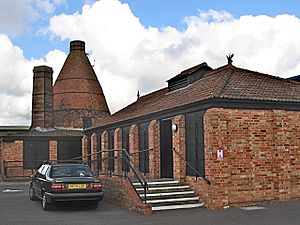Somerset Brick and Tile Museum facts for kids
 |
|
| Lua error in Module:Location_map at line 420: attempt to index field 'wikibase' (a nil value). | |
| Established | 1990s |
|---|---|
| Location | Bridgwater, Somerset |
The Somerset Brick and Tile Museum is a cool place to visit in Bridgwater, Somerset, England. It's run by The South West Heritage Trust. This museum teaches you all about how bricks and tiles were made in Somerset. Bridgwater was a busy town for making things since the Middle Ages. It had lots of special clay from the River Parrett. This clay was perfect for making strong bricks and tiles. Back in the 1840s, about 1,300 people in Bridgwater worked making bricks and tiles.
Contents
What is the Somerset Brick and Tile Museum?
The Somerset Brick and Tile Museum shows how people used to make bricks and tiles. These were very important for building homes and other structures. The museum helps us understand the history of building materials in the area. It also shows how important the local clay was for this industry.
Why Bridgwater Was Perfect for Brick Making
Bridgwater was a great spot for making bricks and tiles. This was because of the special clay found near the River Parrett. This clay came from alluvial deposits, which means it was left behind by the river over many years. This natural resource made Bridgwater a center for this type of work.
The Chandos Glass Cone: A Unique Building
The Chandos Glass Cone is a very old and interesting building. It was built in 1725 by James Brydges, 1st Duke of Chandos. He wanted it to be a kiln for making glass. A kiln is a special oven used for baking things like pottery or glass at very high temperatures.
From Glass to Bricks
After a short time, the Chandos Glass Cone was changed. Instead of making glass, it started making pottery, bricks, and tiles. This continued for a long time, until 1939. Most of this tall, cone-shaped brick building was taken down in 1943. But the bottom 2.4 meters (about 8 feet) of it was saved. It is now protected as an ancient monument.
The Last Pinnacle Kiln in Bridgwater
The museum has the very last 'pinnacle kiln' left in Bridgwater. This kiln is from the 1800s. It is also protected as an ancient monument and a Grade II* listed building. This means it's a very important historical structure.
How the Brick Industry Changed
This kiln used to be one of six at the old Barham Brothers' Yard. The brick-making business started to slow down in the 1900s. Bricks from the London Brick Company were more even in shape. Also, people started using more concrete after World War II. The last time this kiln was used was in 1965. That was the same year the factory closed down. Another kiln, built in 1858, was changed to be more energy-efficient.
Visiting the Museum Today
The old brick works were turned into the museum in the 1990s. When you visit, you can see the tools people used. You can also learn about the different ways they made bricks, tiles, and special terracotta plaques. It's a great way to see how things were made long ago.

